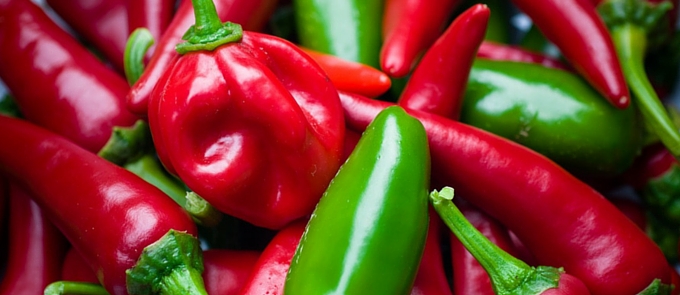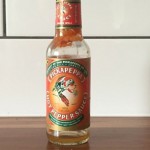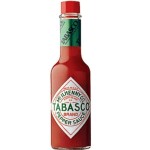
There are literally dozens of chili pepper varieties, ranging in taste from sweet and mild to a four-alarm blaze inside your mouth. Different types of chili peppers are used to flavour the signature dishes of many different countries. The spiciness of chili peppers comes from a chemical called capsaicin, and spiciness is measured in Scoville heat units.
Bell Pepper (Very Mild)
One of the mildest chili peppers is the bell pepper. Bell peppers come in a variety of colours, and colour is determined by the maturity of the pepper, as is flavour. For instance, red bell peppers are just mature green bell peppers. However, bell peppers are never spicy. They can be eaten raw or cooked. Bell peppers are a very versatile chili pepper and are a great way to add flavour and colour to your salad or main dish.
Try them in a casserole, an omelette, or a quiche. Use them as a pizza topping. Add them to a crock of chili or to homemade pasta sauce. Stuffed bell peppers are another versatile and highly popular food. Typically, bell peppers are stuffed with rice or another type of grain such as quinoa, meat, cheese, and/or vegetables, and then baked.
Banana Pepper (Mild)
Another mild chili pepper is the banana pepper. Banana peppers are typically light green or yellow-green and are often pickled, although they can also be eaten fresh. Banana peppers taste great in salad or with pizza. Try them on your sandwich. Banana peppers, like bell peppers, can be stuffed with meat and cheese and baked.
Poblano Peppers (Mild)
Poblano peppers, another mild chili pepper, are native to Puebla, Mexico, and are extremely popular in Mexico. Poblano chili peppers are typically dark green, although if you find a red one, it may be a little spicier than you anticipated. Poblano peppers are also called chile anchos and are a great source of vitamin C. They can be eaten fresh or dried. You can add Poblano peppers to traditional Mexican sauces or use them in salsa. They can also be stuffed.
One of the most popular dishes featuring Poblano peppers is chile relleno, which is a dish of Poblano peppers, cheese, sauce, and sometimes meat. Chiles en nogada is another popular Mexican dish featuring the Poblano pepper. This dish is red, white, and green–the colours of the Mexican flag–and often served for Mexican Independence Day.
Pimientos (Mild)
Pimiento chili peppers are also called cherry peppers, perhaps because of their deep red hue. They are mild-tasting and heart-shaped and usually picked in the late summer or early fall. Paprika, the national spice of Hungary, is made from dried pimiento peppers. Paprikash is a traditional Hungarian dish featuring paprika with chicken. One of the most iconic dishes featuring pimientos is, of course, pimiento cheese, which is delicious on a sandwich.
Jalapenos (Medium)
If you’re in the mood for something a little spicier but don’t want steam coming out of your ears, try a jalapeno pepper. Jalapeno peppers are one of the most popular chili peppers and are normally picked while green, although they will turn red if allowed to ripen. One variety of jalapenos, the purple jalapeno pepper, turns purple before turning red when fully ripe. Red jalapeno peppers that are dried and smoked are called chipotle peppers. Jalapenos can also be eaten fresh or pickled. Add jalapenos to sandwiches, dips, chili, or other dishes to give them a spicy kick.
Cayenne Peppers (Medium)
Cayenne peppers, which are spicier than jalapenos, are typically ground and made into the cayenne pepper spice, which is used to flavour hot sauce. Cayenne peppers are named for the city of cayenne in French Guiana, where the peppers were first grown and used. Cayenne pepper adds spice and flavour to just about any food.
Thai Chilies (Medium)
There are several varieties of chili pepper referred to as Thai chili peppers, including the Kashmir variety, which is also called sriracha and used to make sriracha sauce. The Thai chili pepper is used in a variety of traditional southern Asian dishes where they are used to make curries, pastes, and sauces.
Serrano Peppers (Hot)
Serrano peppers look like a smaller version of a jalapeno. When unripe, they are green, but when they ripen, they turn red, yellow, and orange. Serrano peppers are spicier than jalapenos but are crisp and flavourful, and they are used in many Mexican dishes, including pico de gallo.
Habanero Peppers (Very Hot)
Habanero chili peppers, generally regarded as one of the spiciest chili peppers, are named after the city of Havana, Cuba, where they were once traded. Habanero peppers have an almost citrusy taste and a smell like flowers, making them an extremely popular pepper despite their heat, which might make you cry if you eat too many. Because they are such a spicy pepper, these peppers are literally too hot to handle. Wear gloves while chopping them to avoid burning your hands, and clean any surfaces such as cutting boards well to avoid transferring the habanero flavour to other foods. Removing the seeds from the pepper before you eat it will also remove some of the heat. In Mexico, habanero peppers are often soaked in tequila to give mixed drinks a spicy kick.
Although habanero peppers are commonly thought to be the spiciest chili pepper on the market, others, such as the scorpion pepper, are even hotter. Peppers this hot are commonly used in sauces or marinades rather than eaten by themselves.
Which chillies are your favourite?
These are just a few of the types of hot peppers available. You can experiment with different chili pepper varieties in many dishes. Try making your own Kung Pao chicken using hot dried chili peppers, or use peppers to make an Italian dish such as pasta with arrabiata sauce or puttanesca sauce, both of which utilize dried chili peppers to spice the dish. When cooking with chili peppers, however, use caution and common sense. Keep in mind that the chemical that gives the peppers their spice is also used as a weapon; capsaicin is the active ingredient in pepper spray. Farmers in Africa and Asia even use peppers to repel large pests, such as elephants, from their crops and villages because the smell deters the elephants. Respect the heat of a hot chili pepper. You can always add more spice to a dish while cooking or at the table, but it is much more difficult to remove heat from food once added.



The article would be a lot more useful with images to illustrate the types of chili’s.
We’ll get around to it very soon!
Thanks Ann.
Hi John
You have no article on the best chilli on the planet Scottish Bonnet
Are you still Chilli Chasing